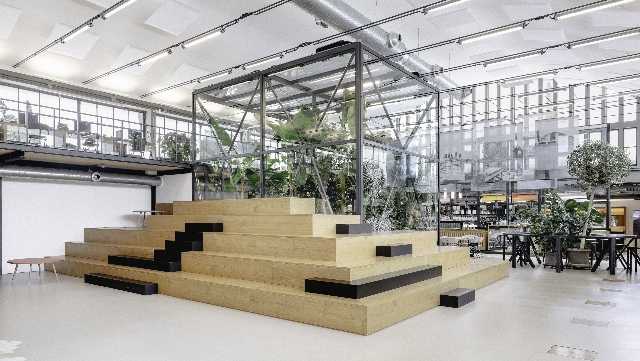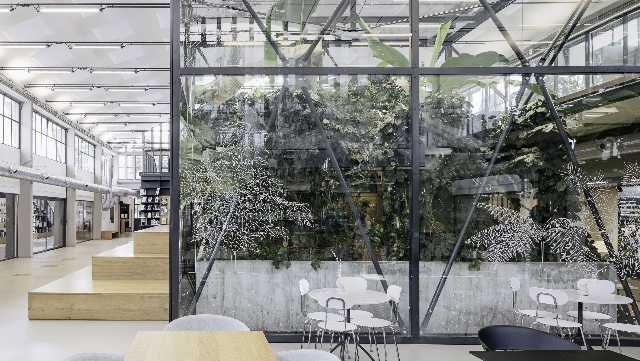PIAN DI SAN BARTOLO, Florence – The International WELL Building Standard includes biophilia as a qualitative and quantitative parameter. Our built environment can shape our habits, regulate our sleep-wake cycle, guide us towards healthy and unhealthy choices, and influence our well-being through the quality of the space in which we live.
Plants produce oxygen and nourishment, improve the quality of spaces, preserve the ecosystem, are extraordinary sensors capable of monitoring any environmental variation and are able to exchange information with each other.
Symbiosis with plants offers solutions to many of the major contradictions and critical issues linked to the development of our species, including the relationship between pollution and the environment.
The integration of plants into the building generates values for occupants in all contexts: from places of learning to care spaces. Plants promote concentration, help reduce stress and positively influence people’s health. All creative, analytical and learning activities are facilitated by the proximity of greenery and the same goes for worker involvement and satisfaction.
The quality of indoor air
In recent years, indoor air quality has finally been recognized as an essential objective of an integrated strategy relating to air pollution as a whole. World Health Organization, through the document “The Right to Healthy Indoor Air”, recognized in year 2000 that healthy indoor air is a fundamental human right.
The poor quality of the air inside closed spaces is, therefore, an increasingly felt issue, given that on average people spend 90% of our time indoors.
Indoor air has the characteristic of being composed of a mixture of substances that is much more variable than the air of outdoor environments. Indoor air pollutants originate from objects, materials and activities present in closed spaces, which is why it often happens that the pollutants detected are present in quantities greater than those measured in the outdoor air or, even, that pollutants are detected indoors not present outdoors.
Indoor environmental pollution comes from different sources, including building materials, furnishings, cleaning products, personal care products and air fresheners. Building occupants also emit many different volatile contaminants in the form of human bioeffluents.
The health effects associated with exposure to indoor air pollutants can be short-term and long-term and can have different levels of severity. Indoor air pollution is considered the third most important cause of disease for the world population3.
Indoor air pollutants
The most common pollutants that we find from the analysis of indoor air can be classified into two categories:
VOCs Volatile organic compounds capable of evaporating easily in the air at room temperature. They are present in many everyday products and building materials.
Fine dust – also called particulate matter: it is the set of solid or liquid substances suspended in air that measure from a few nanometers to 100 µm. they are among the most frequent pollutants in urban areas
Sources of indoor pollution
Home – Tobacco smoke, gas ovens, boilers, wood ovens and fireplaces, building materials, furnishings, household cleaners, electrical equipment
Office/School – Tobacco smoke, construction materials, furniture, printers and photocopiers, air conditioning and ventilation systems, stationery and school supplies

Fabbrica dell’Aria at Accademia del Caffè Espresso
Fabbrica dell’Aria is an innovative botanical filtration system, which purifies indoor air from pollutants through the use of plants. It is a replicable, scalable bio-machine whose performance is measurable.
Plants are not just decorative elements, but the technological heart of a new design concept.
In April 2022, an Air Factory was installed in the premises of Accademia del Caffè Espresso thanks to the conversion of a greenhouse already used for the ornamental cultivation of coffee plants.
In this space, the Fabbrica dell’Aria interprets the vocation of the site by placing the coffee plants at the center of attention, which are associated with banana trees and other plant species, to reproduce the habitat and microclimate typical of tropical areas. In this installation the coffee plant is thought of as the protagonist, acting as the main actor in the air purification process.
How the Air Factory works
Fabbrica dell’Aria is equipped internally with tanks equipped with Stomata technology; this allows the air to diffuse better within the substrate, coming into contact with the root system and the complex system of microorganisms, mainly responsible for the degradation of the target pollutants.
A further filtration stage is given by the leaves, which absorb the pollutants still present, degrade them and convert them into other compounds useful for plants. the sensors measure the data of the incoming and outgoing air in real time, measuring the reduction of pollutants.
For this specific installation it was decided to combine the plants normally chosen for botanical filtration with those for coffee which guarantee the pursuit of the objective of air purification.
Each Air Factory is equipped with a measuring instrument (sensor) capable of measuring the quality of the incoming and outgoing air in real time in order to promptly quantify the air purification action and be able to correlate it to any known agents present at times of greatest concentration of pollutants.
In short, it is possible to both measure the quality of the air and the purifying action of the filtration system.

The data obtained is transmitted to a dashboard which allows it to be collected and displayed (always in real time) on site and on any dedicated online spaces.
The data
The sensors installed in the FdA are able to measure the following data in real time:
– Thermal Comfort Index The thermal comfort index is the combination of air temperature and humidity, as the most common physical factors that could influence the well-being of the occupants of a building.
– Indoor Air Quality Index The indoor air quality index takes into account the air quality parameters (CO2, PM and VOC) that affect the health and comfort of people in the building.
– Environmental Indoor Air Quality Index The environmental indoor air quality index combines the two previous indices. The EIAQI informs users about the general comfort status of the room
– Temperature
– Ambient humidity
– Quantity of pollutants absorbed in real time by the system: VOCs and PM2.5
Considering that the FdA in the Espresso Coffee Academy has been active for 24 months we can estimate that the total values of pollutants removed to date are the following:
– 2386mg fine dust
– 2406g volatile compounds
To get an idea of the positive effects on the treated air it is useful to observe how the purification levels vary in the different months of the year. In fact, in the winter season, the removal of PM2.5 is significantly higher than that measured in the summer months. This may be due to multiple factors, including greater air pollution due to building heating systems (and therefore a greater concentration of pollutants) or even to the lesser exchange of air between the outside and inside of buildings, in this case highlighting how the source of pollutants is often internal. (See Image 1)



To illustrate the FDA’s ability to reduce the CO2 content in the air, we report a graph that represents the daily trend in which the increase in concentration is recorded in the central hours of the day. From the graph you can see how the reduction of CO2 is almost constant even when the concentration of Co2 varies. (See Image 6)

The Air Factory is a multipurpose tool that allows us to actively act on the quality of indoor air through purification, improve the liveability of spaces thanks to the biophilic action but it can also be thought of as an important monitoring tool which, thanks to the sensor component, allows us to promptly know the values of the main indoor air pollutants present in the spaces in which we live, giving us the opportunity to understand and perhaps even intervene on the sources of direct pollution.



















